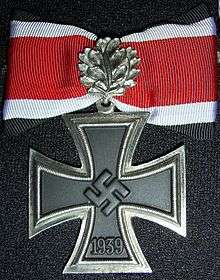Johann Schwerdfeger
| Johann Schwerdfeger | |
|---|---|
| Born |
24 November 1914 Plein, Germany |
| Died | 29 December 2015 (aged 101) |
| Allegiance |
|
| Service/branch | Heer |
| Years of service |
1935–37 1939–45 |
| Rank | Oberfeldwebel |
| Unit | 101st Jäger Division |
| Battles/wars | |
| Awards | Knight's Cross of the Iron Cross with Oak Leaves |
Johann Schwerdfeger (24 November 1914 – 29 December 2015)[1] was a non-commissioned officer who served in the German army during World War II. He was a recipient of the Knight's Cross of the Iron Cross with Oak Leaves (medals recognising extreme battlefield bravery or successful military leadership). The film Cross of Iron is based upon the novel The Willing Flesh, by Willi Heinrich, published in 1956; it may be loosely based on Schwerdfeger's story.[2] He turned 100 in November 2014.[3]
Service history
Schwerdfeger soldiered from 1935 to 1937 in Infanterie Regiment 84, and in 1939 was transferred to the third company of Infanterie Regiment 186 of the 73rd Infantry Division, at the Polish Campaign's start. In June 1942, after serving in Jägerersatzbataillon 75, Schwerdfeger joined Jäger Regiment 228 of the 101st Jäger Division, who fought in the Don Bend, at Rostov, and at Maikop, in the Caucasus, and joined the retreat through the Kuban and the Taman Peninsula, the setting of the novel Das Geduldige Fleisch (The Willing Flesh). On 17 May 1943 Schwerdfeger was awarded the Knight's Cross as a Zugführer (platoon leader) in the First Company. In April 1944, in the breakout from Hube's Pocket, he was severely wounded, and was awarded Oak Leaves for his Knight's Cross on 14 May 1944; moreover, Sergeant Schwerdfeger also earned two tank destruction badges. Schwerdfeger was able to recover from his wounds sustained in Hube's Pocket and served the remainder of the war.
Awards
- Iron Cross (1939)
- Infantry Assault Badge
- 2 Tank Destruction Badges for Individual Combatants
- Knight's Cross of the Iron Cross with Oak Leaves
- Knight's Cross on 17 May 1943 as Feldwebel and Zugführer (platoon leader) in the 1./Jäger-Regiment 228[5]
- 474th Oak Leaves on 14 May 1944 as Oberfeldwebel and Zugführer (platoon leader) in the 1./Jäger-Regiment 228[6]
References
Citations
- ↑ Johann Schwerdfeger, Traueranzeige, trierischer_volksfreund, Gedenkkerzen, Kondolenzen, Fotos
- ↑ funtrivia
- ↑ "Johann Schwerdfeger wurde 100 Jahre" (PDF). Das Rathaus - Wittlich Land (in German). 44 (125): 22. 2014-11-28. Retrieved 2014-12-01.
- 1 2 Thomas 1998, p. 309.
- ↑ Fellgiebel 2000, p. 322.
- ↑ Fellgiebel 2000, p. 70.
Bibliography
- Fellgiebel, Walther-Peer (2000) [1986]. Die Träger des Ritterkreuzes des Eisernen Kreuzes 1939–1945 — Die Inhaber der höchsten Auszeichnung des Zweiten Weltkrieges aller Wehrmachtteile [The Bearers of the Knight's Cross of the Iron Cross 1939–1945 — The Owners of the Highest Award of the Second World War of all Wehrmacht Branches] (in German). Friedberg, Germany: Podzun-Pallas. ISBN 978-3-7909-0284-6.
- Schaulen, Fritjof (2005). Eichenlaubträger 1940 – 1945 Zeitgeschichte in Farbe III Radusch – Zwernemann [Oak Leaves Bearers 1940 – 1945 Contemporary History in Color III Radusch – Zwernemann] (in German). Selent, Germany: Pour le Mérite. ISBN 978-3-932381-22-5.
- Scherzer, Veit (2007). Die Ritterkreuzträger 1939–1945 Die Inhaber des Ritterkreuzes des Eisernen Kreuzes 1939 von Heer, Luftwaffe, Kriegsmarine, Waffen-SS, Volkssturm sowie mit Deutschland verbündeter Streitkräfte nach den Unterlagen des Bundesarchives [The Knight's Cross Bearers 1939–1945 The Holders of the Knight's Cross of the Iron Cross 1939 by Army, Air Force, Navy, Waffen-SS, Volkssturm and Allied Forces with Germany According to the Documents of the Federal Archives] (in German). Jena, Germany: Scherzers Miltaer-Verlag. ISBN 978-3-938845-17-2.
- Thomas, Franz (1998). Die Eichenlaubträger 1939–1945 Band 2: L–Z [The Oak Leaves Bearers 1939–1945 Volume 2: L–Z] (in German). Osnabrück, Germany: Biblio-Verlag. ISBN 978-3-7648-2300-9.
